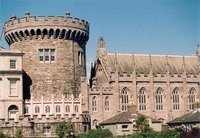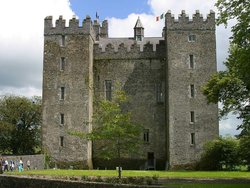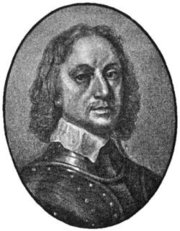Irish Confederate Wars
|
|
The Irish Confederate Wars were fought in Ireland between 1641 and 1653. The Wars were the Irish theatre of the Wars of the Three Kingdoms - a series of civil wars in Kingdoms of Ireland, England and Scotland (all ruled by Charles I of England) that also included the English Civil War and Scottish Civil War. The conflict in Ireland essentially pitted the native Irish Roman Catholics against the Protestant British settlers and their supporters in England and Scotland.
The war in Ireland began with the rebellion of the Irish of Ulster in October 1641, during which they killed thousands of Scots and English Protestant settlers. The rebellion spread throughout the country and at Kilkenny in 1642 the association of The Confederate Catholics of Ireland was formed to organise the Irish Catholic war effort. The Confederation was essentially an independent state and was a coalition of all shades of Irish Catholic society, both Gaelic and Old English. The Irish Confederates professed to side with the English Royalists during the ensuing civil wars, but in reality fought their own war in defence of Irish Catholic interests.
The Confederates ruled Ireland as a de facto sovereign state until 1649, outwardly remainingly loyal to King Charles I. It was the only such assembly to occur in Ireland until 1919 when the Irish Dáil first sat. From 1641to 1649, the Confederates fought with Scottish Covenanter and English Parliamentarian armies in Ireland. They were loosley allied with the English Royalists, but were divided over whether to send military help to them in the English Civil War. Ultimately, they never sent troops to England, but did send an expedition to help the Scottish Royalists, sparking the Scottish Civil War. The wars ended in the defeat of the Confederates. They and their Royalist allies were crushed during the the Cromwellian conquest of Ireland by the New Model Army under Oliver Cromwell in 1649-53. The wars caused massive loss of life in Ireland, comparable in the country's history only with the Great Famine of the 1840s and also saw the mass confiscation of land owned by Irish Catholics.
Military history
For the political context of this conflict, see Confederate Ireland. This article is concerned with the military history of Ireland from 1641-53.
| Contents |
The Plot - October 1641
See also Irish Rebellion of 1641
The Irish Rebellion of 1641 was intended to be a swift and mainly bloodless seizure of power in Ireland by a small group of conspirators led by Phelim O’Neill. Small bands of the plotter’s kin and dependants were mobilised in Dublin, Wicklow and Ulster, to take strategic buildings like Dublin Castle. Since there were only a small number of English soldiers stationed in Ireland, this had a reasonable chance of succeeding. Had it done so, the remaining English garrisons could well have surrendered, leaving Irish Catholics in a position of strength to negotiate their demands for civil reform, religious toleration and Irish self-government. However, the plot was betrayed at the last minute and as a result, the rebellion degenerated into anarchic violence. Following the outbreak of hostilities, the festering hatred of the native Irish Catholic population for the British Protestant settlers exploded into violence.
The Rebellion - 1641-42
From 1641 to early 1642, the fighting in Ireland was characterised by small bands, raised by local lords or among local people, attacking civilians of opposing ethnic and religious groups. At first, Irish Catholic bands, particularly from Ulster, took the opportunity given them by the collapse of law and order to settle scores with Protestant settlers who had occupied Irish land in the plantations of Ireland. Initially, the Irish Catholic gentry raised militia forces to try and contain the violence, but afterwards, when it was clear that the government in Dublin intended to punish all Catholics for the rebellion, participated in the attacks on Protestants and fought English troops sent to put down the rebellion. In areas where British settlers were concentrated, around Cork, Dublin, Carrickfergus and Derry, they raised their own militia in self-defence and managed to hold off the rebel forces. All sides displayed extreme cruelty in this phase of the war. Around 4000 Protestants were massacred and a further 12,000 may have died of privation after being driven from their homes. In one notorious incident, the Protestant inhabitants of Portadown were taken captive and then massacred on the bridge in the town. The settlers responded in kind, as did the Government in Dublin, with attacks on the Irish civilian population. In addition, the English Parliament passed an Ordinance of No Quarter against the Irish rebels, meaning that prisoners were to be killed when taken. The rebels from Ulster defeated a government force at Julianstown, but failed to take nearby Drogheda and were scattered when they advanced on Dublin.
The Confederate’s war - 1642-48
See also Confederate Ireland
Kilkenny_castle.jpg
King Charles I sent a large army to Ireland in 1642 to put down the rebellion, as did the Scottish Covenanters. These armies quickly drove the Irish out Ulster and from around Dublin. In self-defence, Irish Catholics formed their own government, the Catholic Confederation and raised their own armies. Almost all Irish Catholics joined the Confederation, with the odd exception like the Earl of Clanricarde, who stayed neutral. They had available to them only the militias and lord’s private levies, commanded by aristocratic amateurs like Lord Mountgarret. These were defeated in a series of encounters with British troops at Liscarroll, Kilrush and New Ross.
However, they were saved from defeat by the outbreak of the English Civil War. Most of the English troops in Ireland were recalled to fight on the Royalist side in the civil war. The Irish Confederates mopped up the remaining garrisons within their territory, leaving only Ulster, Dublin and Cork in British hands. The remaining British forces were disunited. The garrison of Cork, commanded by Inchiquinn, sided with the Parliament, as did the British settler army around Derry, whereas the troops on Ireland’s east coast, commanded by Earl of Ormonde, sided with the King. The Scottish Covenanter army pursued the agenda of the Edinburgh based Scottish government, allied with the Parliament up to 1647.
Stalemate
This gave the Confederates breathing space to create regular, full time armies. They supplied these by creating an extensive system of taxation throughout the country, centred on their capital at Kilkenny. They also received modest subsidies of arms and money from France, Spain and the Papacy. The Confederate armies were commanded mainly by professional Irish soldiers such as Thomas Preston and Owen Roe O'Neill, who had served in the Spanish army in the Thirty Years War. In total, the Confederates managed to put around 60,000 men into the field in different armies in the course of the war. Arguably, the Confederates squandered the military opportunity presented to them by the English Civil War to re-conquer all of Ireland. They signed a truce with the Royalists in 1643 and spent the next three years in abortive negotiations with them. It was not until 1646 that they launched a determined offensive on the Protestant enclaves in Ireland. Between 1642 and 1646, the war in Ireland was dominated by raids and skirmishes. All sides tried to starve their enemies by burning the crops and supplies in their territory. This fighting caused great loss of life, particularly among the civilian population, but saw no significant battles. The Confederates failed to capture any significant territory, with the exception of Thomas Preston’s successful siege of Duncannon in 1645.
Refugees
The opening years of the war saw widesread displacment of civilians - both sides practising what would now be called ethnic cleansing. In the initial phase of the rebellion in 1641, the vulnerable Protestant settler population fled to walled towns such as Dublin, Cork and Derry for protection. Others fled to England. When Ulster was occupied by Scottish Covenanter troops in 1642, they retaliated for the attacks on settlers by attacks on the Irish Catholic civilian population. As a result, it has been estimated that up to 30,000 people fled Ulster in 1642, to live in Confederate held territory. Many of them became camp followers of Owen Roe O'Neill's Ulster Army, living in clan-based groupings called "creaghts" and driving their herds of cattle around with the army. Outside of Ulster, the treatment of civilians was less harsh, although the "no-mans-land" in between Confederate and British held territory in Leinster and Munster was repeatedly raided and burned, with the result that it too became de-populated.
Victory and Defeat for the Confederates
However, all this changed in 1646, with the end of the first English Civil War. The Confederates abandoned negotiations with the defeated Royalists and tried to re-take all of Ireland before the English Parliament could launch an invasion of the country. They were bolstered by the arrival in Ireland of the Papal Nuncio, Rinuccini, who brought with him large amounts of money and arms. They managed to capture a Parliamentarian stronghold at Bunratty castle in Clare and to smash the Scottish Covenanter army at the battle of Benburb and also take Sligo town. Late in the year, the Ulster and Leinster Confederate armies under Owen Roe O'Neill and Thomas Preston (a total of 18,000 men) laid siege to Dublin, trying to take the city off Ormonde’s Royalist garrison. However Ormonde had devastated the land around the capital and the Confederates, unable to supply their troops, had to lift the siege. In hindsight, this was the high tide for the Irish Confederates. Ormonde, who said that he, "preferred English rebels to Irish ones", left Dublin and handed it over to a Parliamentarian army under Michael Jones.
In 1647, The Parliamentarian forces inflicted a shattering series of defeats on the Confederates, ultimately forcing them to join a Royalist coalition to try and hold off a Parliamentarian invasion. Firstly, in August 1647, Thomas Preston’s Leinster army was annihilated at the battle of Dungans Hill by Jones’ Parliamentarian army when it tried to march on Dublin. This was the best trained and best equipped Confederate army and the loss of its manpower and equipment was a body blow to the Confederation. Secondly, the Parliamentarians in Cork devastated the Confederate’s territory in Munster, provoking famine among the civilian population. When the Irish Munster army brought them to battle at Knocknanauss, they too were crushed. Sligo also changed hands again -captured by the Ulster British settler's army. It is noticeable that the battles in this phase of the war were exceptionally bloody, with the losers having up to half of their men killed. This string of defeats forced the Confederates to come to a deal with the Royalists, and to put their troops under their command. Amid factional fighting within their ranks over this deal, the Confederates dissolved their association in 1648 and accepted Ormonde as the commander in chief of the Royalist coalition in Ireland. Inchiquinn, the Parliamentarian commander in Cork also defected to the Royalists.
The Cromwellian War 1649-1653
See also Cromwellian conquest of Ireland
The Confederate/Royalist coalition wasted valuable months fighting with Owen Roe O'Neill and other former Confederates who refused to accept the dissolution of the Confederation. Belatedly, in August 1649, Ormonde tried to capture Dublin, but was routed by Jones at the battle of Rathmines. Oliver Cromwell landed shortly afterwards with the New Model Army. Cromwell was able to succeed in three years in conquering the entire island of Ireland, because his troops were supplied, well equipped (especially with artillery) and well trained. Moreover, he had a huge supply of men, money and logistics to fund the campaign.
The Cromwellian Conquest
His first action was to secure the east coast of Ireland for supplies of men and logistics form England. To this end, he took Drogheda (See also siege of Drogheda) and Wexford, perpetrating massacres of the defenders of both towns. He also sent a force to the north to link up with the British settler army there. Those settlers who supported the Scots and Royalists were defeated by the Parliamentarians at the battle of Lisnagarvey.
Ormonde signally failed to mount a military defence of southern Ireland. He based his defences on walled towns, which Cromwell systematically took one after the other with his ample supply of siege artillery. However, the Irish and Royalist field armies did not hold any strategic line of defence and instead were demoralised by a constant stream of defeats and withdrawals. Only at the siege of Clonmel did Cromwell suffer significant casualties (although disease also took a very heavy toll on his men). However, his losses were made good by the defection of the Royalist garrison of Cork, who had been Parliamentarians up to 1648, back to the Parliament side. Cromwell returned to England in 1650, passing his command to Henry Ireton.
In the north, the Parliamentarian/settler army met the Irish Ulster army at the battle of Scarrifholis and destroyed it. Ormonde was discredited and fled for France, to be replaced by Clanricarde. By 1651, the remaining Royalist/Irish forces were hemmed into an area west of the Shannon, holding only the fortified cities of Limerick and Galway and an enclave in County Kerry, under Viscount Muskerry. Ireton besieged Limerick while the northern Parliamentarian army under Charles Coote besieged Galway. Muskerry made an attempt to relieve Limerick, marching north from Kerry, but was routed by Roger Boyle at the battle of Knocknaclashy. Limerick and Galway were too well defended to be taken by storm, but were blockaded until hunger and disease forced them to surrender, Limerick in 1651, Galway in 1652. Waterford and Duncannon also surrendered in 1651.
- See also sieges of Limerick
Old-Galway.jpg
Guerrilla War
This was the end of organised Irish resistance, but because the Cromwellian surrender terms were so harsh, many small units of Irish troops fought on as guerrillas, or "tories" as they were called at the time. Undoubtedly some of the tories were simple bandits, whereas others were politically motivated. The Cromwellians distinguished in their rewards between "private tories" and "public tories". This phase of the war may actually have been the most costly in terms of civilian loss of life. The tories, who were usually former Confederate soldiers, operated from rugged areas such as the Wicklow Mountains, attacking vulnerable groups of Parliamentarian soldiers and looting their supplies. In response,the Parliamentarians designated areas as what is now called, "free fire zones", forcibly evicting the civilian populations from areas which had been helping the tories and burning their crops. These areas could be very large, including almost all of county Wicklow. The result of this fighting was famine throughout the country, which was aggravated by an outbreak of bubonic plague. Disease of course killed indiscriminately, Ireton himself died of plague outside Limerick in 1651. The last organised Irish troops surrendered in Cavan in 1653, when the Cromwellians agreed to let them be transported to serve in the French army - the English Royalist Court was in exile in France. However, any troops captured in this phase of the war were either executed or transported to penal colonies in the West Indies (especially Barbados, where their descendants are known as Redlegs). Even after the formal surrender , Ireland was plagued with small scale violence for the remainder of the 1650s.
The Cost
The death toll of the conflict was huge. William Petty, a Cromwellian who conducted the first scientific land and demographic survey of Ireland in the 1650s, concluded that at least 400,000 people and maybe as many as 620,000 had died in Ireland between 1641 and 1653. The true figure may be lower, but the lowest suggested is about 200,000. And this in a country of only around 1.5 million inhabitants. It is estimated that about two thirds of the deaths were civilian. The Irish defeat led to the mass confiscation of Catholic owned land and the British Protestant domination of Ireland for over two centuries.
Sources
- Padraig Lenihan, Confederate Catholics at War, Cork 2001
- Jane Ohlmeyer, John Keegan (ed’s), The Civil Wars, Oxford 1998.
- G.A. Hayes McCoy, Irish Battles, Belfast 1990.
- James Scott Wheeler, Cromwell in Ireland, New York 1999
Links
PEOPLE associated with the period include;
Soldiers: Owen Roe O'Neill, Thoma Preston, Alasdair MacColla, Hugh Dubh O'Neill, Henry Ireton, George Monck, Oliver Cromwell, Garrett Barry, Roger Boyle, 1st Earl of Orrery, Murrough O'Brien, Earl Inchiquinn.
Political figures: Phelim O'Neill, James Butler, 1st Duke of Ormonde, Patrick Darcy, Richard Martin fitz Oliver, Ulick de Burgh, 5th Earl of Clanricarde, Richard Bellings, Nicholas French, Nicholas Plunkett, Giovanni Battista Rinuccini, Charles I, Charles II Mountgarret Viscount Gormanstown.
others: Piaras Feiritear and Daibhi O Bruadair - poets William Petty (geographer)
Places associated with the period include;
Drogheda, Limerick, Dublin, Cork, Galway, Clonmel, Derry, Rathfarnham Castle, Trim Castle, Cahir Castle, Narrow Water, Bunratty Castle, Derry, Portadown, Ross Castle
See Also



